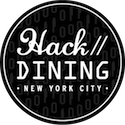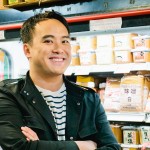Guest post by Mike Lee and Meredith Micale of Studio Industries. The views expressed here are solely those of the author and do not reflect the views of Food+Tech Connect.
The future of food needs design. We’re not just talking about aesthetics, we’re talking about staying sensitive to people’s needs as food producers, distributors, cooks and consumers. The future will inevitably bring a bounty of innovations in food technology, and in our world with so much transitioning from atoms to bits, it will become increasingly critical to keep people at the core of design decisions around food.
Food, like technology, is adaptable, and the ways in which we interact with it and experience it are constantly changing. With the complexities of interconnected food systems, it will be evermore important to understand people, the context in which they live and work, and perhaps most importantly, to ask the right questions before jumping to solutions. By focusing on people’s needs, instead of technology or a product, we are in a better position to design relevant solutions that have enduring impact.
While it can be tempting to fixate on the shiny new object–the app that tells us exactly what to eat and when to eat it, or the alternative sugar that’s nutritious, delicious and natural–we can’t lose sight of who those technologies are for in our effort to build those products. Just because we can build it, doesn’t mean that we should.
One example that illustrates the value of paying close attention to the user comes from rural Cambodia, where anemia is a particularly common health problem. In this case, the general solution doesn’t happen to be terribly complex. Cooking with a simple piece of iron in your pot can add enough iron to ward off anemia. So that’s what epidemiologist Christopher Charles did. He created small iron blocks that were handed out to households with instructions to place them in their cooking pots. Unfortunately, however, the people chose to not adopt this new behavior, and the iron blocks were mostly repurposed as door stops or paperweights instead of cooking accompaniments.
After closer conversation with the local Cambodians with whom he lived, Charles was inspired by the fact that the fish is a sign of good luck in Cambodian culture. Charles quickly refurbished the iron lumps into fish-shaped forms and saw that the usage rate shot up to 92%.
Despite rational understanding that iron could help solve their health issues, it wasn’t until the fish came along that locals had an emotional hook to use the iron. It was a simple solution using existing technology and materials, yet was user-sensitive and impactful. The Lucky Iron Fish was designed for their way of life, and as a result, could be easily integrated into their lives. Anemia was effectively curtailed in all test neighborhoods.
The Lucky Iron Fish story is great design at work. But it’s important to note that the “design” lesson here isn’t just about form-factor design or marketing to local tradition. Fabricating the iron fish was the design output of this project, but the design process started well before that when Charles opened his eyes and ears, and started to pay closer attention to the Cambodians way of life. The fact that a fish is a lucky symbol to Cambodians would never come up in a market research survey or grocery scanner report. These are the details a project’s success can hinge upon, and they can only come from truly understanding the details of life for the people who you’re designing for.
The act of taking a step back and examining the user(s) and their context more thoughtfully can have a huge impact on your eventual solution. The Lucky Iron Fish example is a small lesson on the perils of jumping directly to the solution before truly understanding who you’re designing for. In a world where our society can build virtually anything we put our resources toward, it’s going to be crucial that we continue to ask the right questions before we build the answers.
Recently at Food + Tech Connect’s Hack // Dining event, we were on hand to help guide hackers toward better solutions, by showing them how to ask better questions. We called this process Design Hacking, and it was a methodology we developed to infuse more design thinking into the breakneck pace of a typical hackathon.
Our main message to the hackers was a bit counter-intuitive, especially to veterans of tech hackathons. We emphasized that “you’re not here to hack technology…you’re here to hack stories.” This reframed the challenge for the hackers to not just focus on cool tech for cool tech’s sake, but to design solutions that actually improve someone’s life story.
The Studio Industries team spent the better part of the first day helping the hackers and stakeholders understand the user journeys of the people they were “hacking” for, such as Chipotle customers or foodservice professionals of Batali & Bastianich Hospitality Group. This simple “mapping” helped hackers identify potentially high value moments where the experience could be elevated and improced. Those high value moments were the focus of the hacking, and often the best solutions didn’t need to be the ones with the most groundbreaking technology.
At the heart of better design in food is the idea that features and technical specs don’t equate to value, people’s experiences do. For food innovators everywhere, we hope the future of food means we all take a stronger design mindset to create the right solutions. By taking a small, yet purposeful shift in how we think about food innovations, we can begin to look around the food world and ask ourselves: where are we making lumps of metal when we should really be making Lucky Iron Fishes?
Hacking Dining is an online conversation exploring how we might use technology and design to hack a better future for dining. Join the conversation between June 2 – July 31, and share your ideas in the comments, on Twitter using #hackdining, Facebook, LinkedIn or Tumblr.
_______________
Mike Lee is the founder and CEO of Studio Industries, a Food Design & Innovation agency, specializing in the application of design thinking to food products and experiences. Mike’s experience in food design & innovation has covered a wide range over the past 10 years. Most recently, Mike led product development initiatives on the Innovation & New Ventures team at Chobani. At Chobani, Mike focused on building out the Greek Yogurt maker’s product platform into new categories and he drove the product design process from research, insights and ideation, to food, flavor and packaging development, and then finally to business planning and production.
Mike also founded the Studiofeast underground supperclub, the sister organization to Studio Industries. Studiofeast creates unique dining experiences that use food as a medium to design experiences that range from the artful, to the educational, to the hedonistic. In addition, Mike is also the Innovation Director for AccelFoods, an early stage food startup accelerator that cultivates and invests in new packaged food brands. Mike is a Detroit native and was trained in Business at the University of Michigan and Graphic Design at the Parsons School of Design. He now lives in Brooklyn, NY.
Meredith Micale is a design strategist driven by transforming consumer insights into business opportunities. She is passionate about helping brands rethink what value means to their customers, and works with companies to design and deliver meaningful products and services with enduring impact.
Applying a strategic lens across a range of projects, Meredith has created new product innovations for multiple consumer house wares companies, designed a digital user interface of a mobile medical cart for a world leader in ergonomic solutions, imagined the future of microwave cooking for a multinational manufacturer of home appliances, created a new brand and product line for a body care and wellness company, and led design research and innovation workshops for diverse industries and clients.
Previously, Meredith led design research and strategy projects at Smart Design in New York City, and the Global Consumer Design studio at Whirlpool Europe in Italy. She holds a BA in Mathematics from the College of Mount St. Joseph, and an MBA in Design and Innovation Strategy from MIP – Politecnico di Milano.
Meredith is passionate about quality ingredients, clean eating, and enjoying lunch as the main meal of the day.






